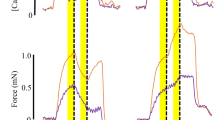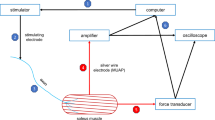Abstract
THE force : velocity properties of extensor digitorum longus (EDL) and soleus (SOL) muscles of the mouse have been determined at birth and four weeks after birth. The methods and recording equipment used in this work have been described in detail elsewhere1. Contractions of muscles in four-week-old animals were recorded in vivo; the anaesthetic was 100 mg pentobarbital sodium/kg body-weight injected intraperitoneally followed by about 40 per cent of the initial dose every hour. Neonatal muscles were examined in vitro; in these conditions the average decline in the maximum isometric tetanic tension (P0) in the course of a series of measurements lasting several hours was only 7 per cent for EDL and 4 per cent for SOL. The speed of shortening was determined from distance : time curves of after-loaded isotonic tetanic contractions. These contractions were recorded with light levers during repetitive indirect stimulation at the optimal frequency (fo). The equivalent masses of the levers were 22 mg and 114 mg for muscles from neonatal and four-week-old animals respectively. All measurements were made with the muscles at 35° C to 35.5° C. Curves describing the relationship between the speed of shortening and the load were fitted to the data for each muscle by the method of least squares using Hill's equation2 ((P + a)V = b(P0 − P), where P0 = maximum isometric tetanic tension, P = load, V = speed of shortening, and a and b are constants). The anatomical arrangement of tendon and muscle fibres in mouse EDL and SOL is the same as that described for rat muscles1.
This is a preview of subscription content, access via your institution
Access options
Subscribe to this journal
Receive 51 print issues and online access
$199.00 per year
only $3.90 per issue
Buy this article
- Purchase on Springer Link
- Instant access to full article PDF
Prices may be subject to local taxes which are calculated during checkout
Similar content being viewed by others
References
Close, R., J. Physiol., 173, 74 (1964).
Hill, A. V., Proc. Roy. Soc., B, 126, 136 (1938).
Author information
Authors and Affiliations
Rights and permissions
About this article
Cite this article
CLOSE, R. Force : Velocity Properties of Mouse Muscles. Nature 206, 718–719 (1965). https://doi.org/10.1038/206718a0
Published:
Issue Date:
DOI: https://doi.org/10.1038/206718a0
This article is cited by
-
A Muscle’s Force Depends on the Recruitment Patterns of Its Fibers
Annals of Biomedical Engineering (2012)
-
Analysis of gene expression differences between utrophin/dystrophin-deficient vs mdx skeletal muscles reveals a specific upregulation of slow muscle genes in limb muscles
Neurogenetics (2006)
-
Dystrophic mice show age related muscle fibre and myelinated axon losses
Nature (1977)
-
Lyse und Regeneration von Fibrillen in der normalen menschlichen Skeletmuskulatur
Virchows Archiv A Pathologische Anatomie (1968)
-
Fasertypen in der Unterschenkelmuskulatur der Maus
Zeitschrift f�r Zellforschung und Mikroskopische Anatomie (1967)
Comments
By submitting a comment you agree to abide by our Terms and Community Guidelines. If you find something abusive or that does not comply with our terms or guidelines please flag it as inappropriate.



